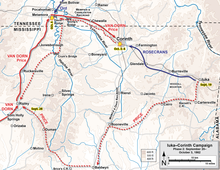4th Missouri Infantry Regiment (Confederate)
| 4th Missouri Infantry Regiment | |
|---|---|
| Active | April 28 to November 7, 1862 |
| Allegiance | |
| Branch | |
| Type | Infantry |
| Size | 547 (May 5, 1862) |
| Engagements | American Civil War |
The 4th Missouri Infantry Regiment was formed on April 28, 1862, and served in the
The combined unit served in the
Background and organization
When the
The 4th Missouri Infantry Regiment was formed on April 28, 1862, in Memphis, Tennessee. Two previously existing battalions, commanded by Archibald A. MacFarlane and Waldo P. Johnson, were combined with a small element of the MSG; many of MacFarlane and Johnson's men were MSG veterans. MacFarlane was appointed the regiment's first colonel, Johnson was the first lieutenant colonel, and Stephen W. Wood was the regiment's first major.[7] On April 28, the regiment contained ten companies, all Missouri-raised; they were designated with the letters A–I and K.[8] Almost all of the regiment's soldiers were of Anglo-Saxon descent.[9]
Service history

After formation, the regiment was transferred by
After escaping, Price joined Van Dorn, who commanded the combined force. Together, the Confederates moved against Corinth, which was strategically important to Union plans in the region. On October 2, Union Major General
After Hébert fell ill, Green was promoted to divisional command on October 4. Command of Green's brigade then fell to Colonel William H. Moore,[17] who led a charge against the inner Union line, to capture a fortification known as Battery Powell. The Union line was defended by men of Davies's division, who were quickly routed by the Confederate charge.[18] After breaking through Davies's line, Moore's brigade aimed for the town of Corinth itself.[19] Along with elements of Phifer's brigade and the brigade of Brigadier General John C. Moore, it entered Corinth and penetrated as far as the Tishomingo Hotel. A Union counterattack drove the Confederates out of Corinth.[20] At Second Corinth, the 4th Missouri lost 129 men: 15 killed, 87 wounded, and 27 missing.[10] MacFarlane suffered a serious head wound during the battle.[8][21]
Legacy

On November 7, in the vicinity of Wyatt, Mississippi, the regiment consolidated with the
In 1863, the new regiment fought at the
As of January 2021, the flag of the 4th Missouri Infantry, a Van Dorn battle flag, is held by the American Civil War Museum in Richmond, Virginia.[25][26]
See also
References
- ^ Kennedy 1998, pp. 19–20.
- ^ Hatcher 1998, pp. 21, 23.
- ^ Kennedy 1998, pp. 23–25.
- ^ Shea & Hess 1998, pp. 34, 36–37.
- ^ Kennedy 1998, p. 38.
- ^ Gottschalk 1991, p. 120.
- ^ McGhee 2008, pp. 200–201.
- ^ a b McGhee 2008, p. 200.
- ^ Tucker 1993, p. 93.
- ^ a b c d e McGhee 2008, p. 201.
- ^ Gottschalk 1991, p. 108.
- ^ Kennedy 1998, p. 129.
- ^ Reaves 1998, pp. 130–131.
- ^ Cozzens 1997, p. 327.
- ^ Cozzens 1997, pp. 205–207.
- ^ Cozzens 1997, pp. 210–214.
- ^ Cozzens 1997, pp. 235–236.
- ^ Cozzens 1997, pp. 240–242.
- ^ Cozzens 1997, p. 245.
- ^ Cozzens 1997, pp. 267–269.
- ^ Tucker 1993, p. 92.
- ^ a b McGhee 2008, pp. 181–184.
- ^ Tucker 1993, pp. 93–94.
- ^ "Sitton, John James (1842–1915)" (PDF). The State Historical Society of Missouri. Archived (PDF) from the original on January 27, 2021. Retrieved January 24, 2021.
- ^ Dedmondt 2009, pp. 83–84.
- ^ "Object Record 0985.08.00014". American Civil War Museum. Archived from the original on January 29, 2021. Retrieved January 24, 2021.
Sources
- Cozzens, Peter (1997). The Darkest Days of the War: The Battles of Iuka and Corinth. Chapel Hill, North Carolina: University of North Carolina Press. ISBN 978-0-8078-2320-0.
- Dedmondt, Glenn (2009). The Flags of Civil War Arkansas. Gretna, Louisiana: Pelican Publishing Company. ISBN 978-1-58980-190-5.
- Gottschalk, Phil (1991). In Deadly Earnest: The Missouri Brigade. Columbia, Missouri: Missouri River Press. ISBN 978-0-9631136-1-0.
- Hatcher, Richard (1998). "Wilson's Creek, Missouri". In Kennedy, Frances H. (ed.). The Civil War Battlefield Guide (2nd ed.). Boston/New York: Houghton Mifflin. ISBN 978-0-395-74012-5.
- Kennedy, Frances H., ed. (1998). The Civil War Battlefield Guide (2nd ed.). Boston/New York: Houghton Mifflin. ISBN 978-0-395-74012-5.
- McGhee, James E. (2008). Guide to Missouri Confederate Regiments, 1861–1865. Fayetteville, Arkansas: University of Arkansas Press. ISBN 978-1-55728-870-7.
- Reaves, George A. (1998). "Corinth, Mississippi". In Kennedy, Frances H. (ed.). The Civil War Battlefield Guide (2nd ed.). Boston/New York: Houghton Mifflin. ISBN 978-0-395-74012-5.
- Shea, William L.; Hess, Earl J. (1998). "Pea Ridge, Arkansas". In Kennedy, Frances H. (ed.). The Civil War Battlefield Guide (2nd ed.). Boston/New York: Houghton Mifflin. ISBN 978-0-395-74012-5.
- Tucker, Phillip Thomas (1993). The South's Finest: The First Missouri Confederate Brigade From Pea Ridge to Vicksburg. Shippensburg, Pennsylvania: White Mane Publishing Co. ISBN 978-0-942597-31-8.
Further reading
- Bryan, William (2014). A Socio-Military History of the Fourth Missouri Infantry Regiment, C.S.A. (Master's thesis). Missouri State University.
